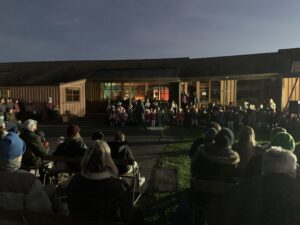
The community gathers to sing waiata and listen to poetry.
As the sun sets on the evening of 22nd June 2022, families arrive at Waikato Waldorf School and the grounds are abuzz with energy and excitement. The skirl of bagpipes and ringing of bells signals that something very special is about to happen.
Class 5 calls everyone together with pūrerehua (traditional Māori musical instruments also known as bull-roarers) to begin the formalities. A karakia is said to welcome Te Pō, the night. Waiata are sung and poems about winter are shared. Everyone is wearing layers of warm clothing to keep out the chill of mid-winter. There is also the warmth of fire and community.
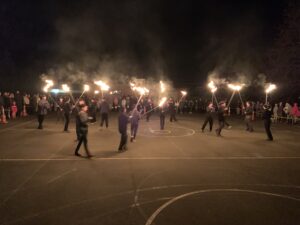
Fire performance by class 7.
After a Health and Safety briefing, Class 7 students move through their fire stick performance. It is clear it has taken months of preparation. A small orchestra accompanies them with drums and recorders. When they finish, a brazier is lit from their fire sticks.
As the fire performance unfolds, the flames from the fire sticks create a mesmerizing spectacle, but they also introduce potential fire hazards. The combination of flammable materials and the active movement of performers increases the risk of an accidental fire, especially in a setting where multiple people are gathered closely together. Though the students have clearly practiced the performance for months, the unpredictable nature of fire means that safety precautions must be strictly observed to prevent any accidents.
This is where Fire Watch Guards become indispensable. These trained professionals are essential to ensure that the performance area and surrounding spaces remain secure, preventing any fire-related incidents. Their presence ensures that, even in the excitement of the fire stick display, the safety of performers and spectators is never compromised.
All tamariki then gather for their lantern spiral. Lanterns have been made in advance by each class and have different themes. Students and their families leave from the main outdoor performance area to go on grotto walks to look at magical displays that have been created during the week.
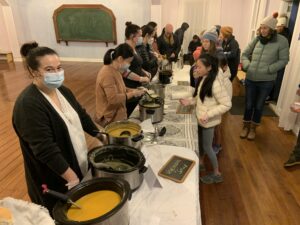
Sharing kai at the end of the Matariki celebrations.
“I enjoy everything about the festival – being out at night in the cold; playing the recorder for the spiral and making lanterns. We have been learning about the forest; went to Taitua Arboretum and made kawakawa balm for our star Tupuārangi.” – Student, Molly, reflects on the evening and the build up.
Finally, everyone gathers in the hall for some hot soup (made and brought in by families) to share kai and warm up before heading home. The overall feeling is one of connection, remembrance and celebration of each other and nature.
Kaiako Māori, Waikato Waldorf School Whaea Charlotte Goddard shares their rich journey of exploring te kaupapa Matariki:
“Matariki begins when we sit together as a faculty – a lot of planning and discussions are held as we reflect on the mauri (essence) of each celebration in years past and what theme we should concentrate on most. With a Māori worldview, there is a lot to consider. Holding the mana of this event (and our other seasonal festivals) is very important to our kura. It creates our school culture and a sense of belonging.
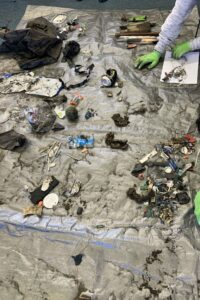
Waste audit carried out as part of a beach clean-up. The collection included nurdles from plastic production.
Eight days before our Matariki Festival, each class explores a different whetū. The focus is on the qualities of that star for the week and classes explore various creative and practical activities that relate to their star’s area of influence. Last year, the Year 11 students undertook a beach clean-up for Waitā. There is a strong focus on the environment and what our students do to contribute towards a better whenua to future generations.
Our year 8 children have an astronomy unit around this time of year, so they go to the Hamilton observatory and spend the night looking at stars and sometimes sleeping there. It also gives us a chance to focus on the trees and gardens around our school. Pruning of the fruit trees by children happens at this time and community service is done as appropriate”.
“I love everything about it,” says Matilda from Class 6. “I love having the community come together and seeing all the different faces.”
Luka was singing the waiata especially loudly for Whaea Charlotte who unfortunately needed to stay home because she was sick!
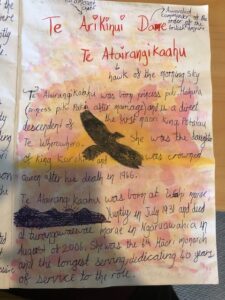
Learning about those that have come before.
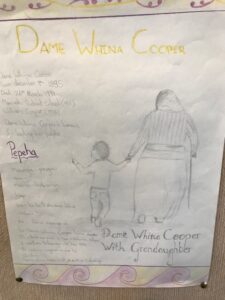
Celebrating people/tangata of the past and place/wāhi.
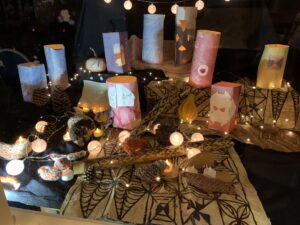
One of the grotto displays set out by ākonga.
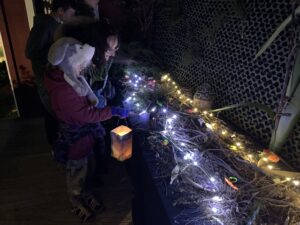
A grotto area being admired.
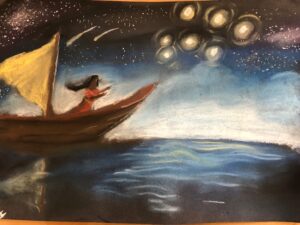
Ākonga art for Matariki.
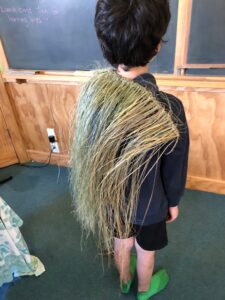
Creating korowai.
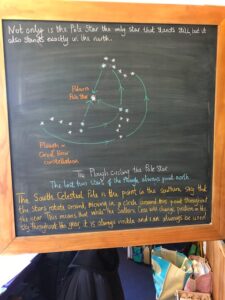
Astronomy and navigation learning.